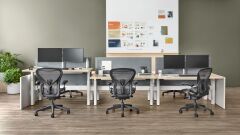As employers race toward the future, it might make more sense for them to take a stroll down memory lane.
“Obviously work has always been at the center of the office,” Kaufmann-Buhler says. “Over history, office design shares a similar idea, which is this idea of creating a physical space that will optimally reflect the corporate hierarchy and core corporate goals and corporate products.”
Read more:
That means that employers can look back at what worked before, in order to create a blueprint for the post-COVID-era. When employees think of the “modern workplace,” they may picture the open-plan layouts, communal seating areas and
“In the post-war era, there was this real idea of marrying the aesthetics of corporate culture with the practical needs of space. I think that is really in many ways still at the center of so much of what office design is,” she says. “What goes around comes back around. I fully expect that we’re going to see people saying, ‘You know what? We discovered this new idea. It's called an office. It's where everybody comes to a physical space where we all work together.’”
Kaufmann-Buhler shared an abridged workplace history for clues into what may be next for the future of work.














